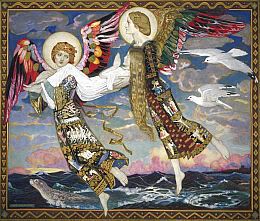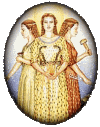
Brigid was supposedly first abbess of a double monastery (for men and women, but mostly for women) in present-day Kildare in Ireland and she is a saint who has always attracted a good deal of legendary material. Reliable sources for her life are exceedingly sketchy and for some they do not even support her existence. The first biography was composed around a century after she is supposed to have died, by a writer called Cogitosus (for much of these details - and much more - see this article by Lisa M Bitel, full reference below, from p. 211 for the biographies). Two further anonymous Lives followed Cogitosus in the subsequent fifty years.
It is these two subsequent Lives which introduced a number of elements of pre-Christian Ireland which have gone on to prompt speculations that Brigid was somehow a pagan goddess claimed by the church. This is stretching the evidence to breaking point. What is interesting is that the eighth and ninth-century Lives wrote with a degree of freedom that allowed pagan content to be introduced into the saint's Life. This material established a connection between the saint and the natural world and tied her in to themes present in secular literature, which sought to evoke a pre-Christian past. These two hagiographers, as Bitel points out, lacked the saint's body, present in Kildare, and appear to have attempted to invoke connections with nature and a kind of patriotic nostalgia for the pre-Christian past in order to claim a saint to whom they lacked direct access.
By around 900, when Cormac
 mac Cuilennain wrote concerning Brigit, the connection with pre-Christian deities was still clearer, as appears to have been the case with ninth century writings concerning a goddess called 'Brig' (for both of these sources, see Bitel, p. 224). The two hagiographers who followed Cogitosus had started a process which then produced something of a creative explosion of pre-Christian beliefs, the nature of which remain steadfastly unclear.
mac Cuilennain wrote concerning Brigit, the connection with pre-Christian deities was still clearer, as appears to have been the case with ninth century writings concerning a goddess called 'Brig' (for both of these sources, see Bitel, p. 224). The two hagiographers who followed Cogitosus had started a process which then produced something of a creative explosion of pre-Christian beliefs, the nature of which remain steadfastly unclear. These speculations are given a further spin by the situating of her feast day on a day, Imbolc, which was of significance to the pre-Christian inhabitants of Ireland. What this significance was - or whether any of its meaning persisted - is unclear, as the early medieval writers who mention it show no evidence of understanding - or being interested in - its significance. A good summary of the evidence can be found in Ronald Hutton's excellent Stations of the Sun. Putting aside any speculation as to a mystical significance to the date of Imbolc, it is of primary importance for the way it marks the seasons changing. Spring seems a long way off at the beginning of February, but at Imbolc according to a tenth or eleventh-century writer (of the Tochmarc Emire from the 'Ulster Cycle', see Hutton, p. 134) the ewes would be milked at this time, at the beginning of spring (originally a couple of weeks later before the calendar was reformed).
These speculations are given a further spin by the situating of her feast day on a day, Imbolc, which was of significance to the pre-Christian inhabitants of Ireland. What this significance was - or whether any of its meaning persisted - is unclear, as the early medieval writers who mention it show no evidence of understanding - or being interested in - its significance. A good summary of the evidence can be found in Ronald Hutton's excellent Stations of the Sun. Putting aside any speculation as to a mystical significance to the date of Imbolc, it is of primary importance for the way it marks the seasons changing. Spring seems a long way off at the beginning of February, but at Imbolc according to a tenth or eleventh-century writer (of the Tochmarc Emire from the 'Ulster Cycle', see Hutton, p. 134) the ewes would be milked at this time, at the beginning of spring (originally a couple of weeks later before the calendar was reformed).Imbolc continues to be an important date for neo-Pagans, following the enthusiastic interest in Celtic traditions and customs. In Britain, outside those areas of strong Irish influence, the key date for the end of winter and the beginning of spring was, however, Candlemas - which is tomorrow.
==========
Full reference for the article referred to above: L Bitel, 'Body of a saint, story of a goddess: origins of the Brigidine tradition', Textual Practice 16(2), 2002, 209-228. It can be accessed online here.
The image at the beginning of this post is 'Saint Bride' by John Duncan (1913), a painting in the National Gallery of Scotland in Edinburgh. More details can be found on their website here. It's been included in this post as 'fair use', for the purpose of study, review or critical analysis only, and will be removed at the request of the copyright holder(s).
No comments:
Post a Comment